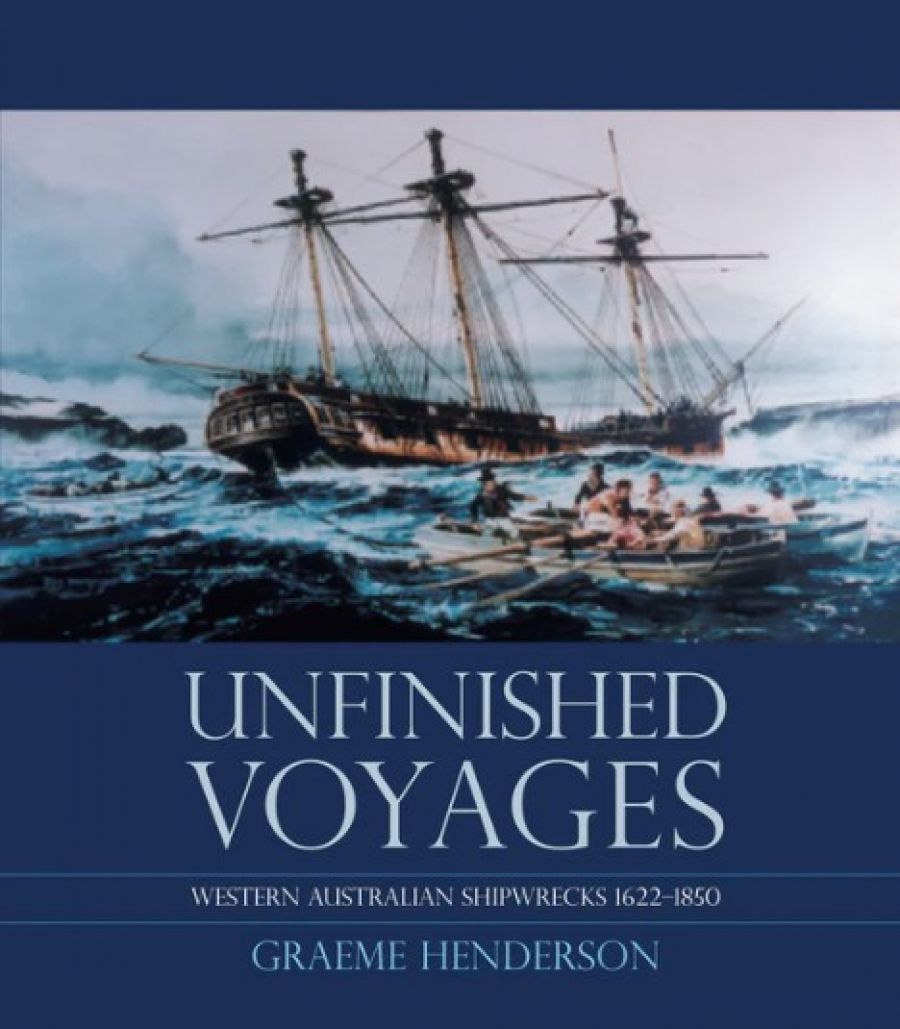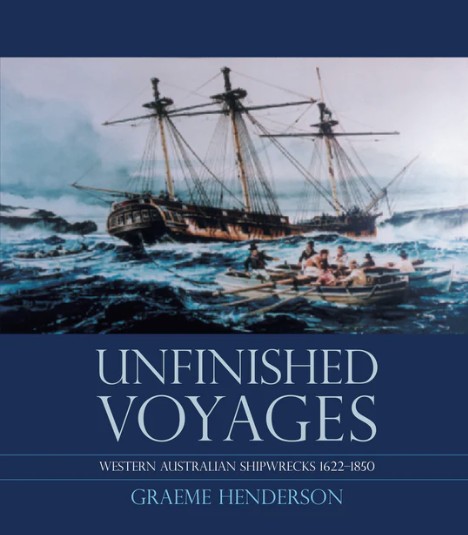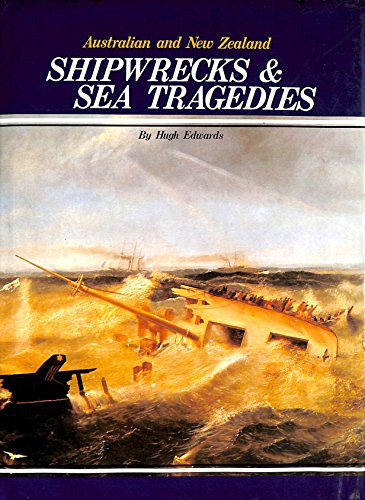
- Free Article: No
- Contents Category: History
- Review Article: Yes
- Article Title: Upon the Wild Ocean
- Online Only: No
- Custom Highlight Text:
Wrecks and the relics of wrecks have always fascinated. Their search and finding brings the excitement of the chase, their identification involves detective sleuthing, their background entails historical research; the very sight of them evokes the adventure of their days of sailing, and the drama of their night of death. Australian writing is rich in books about them, with earlier emphasis more on the adventure and the drama, less on the historical research and the archaeological interpretations. But with the coming of modern underwater techniques and sophisticated instruments, the haphazard sampling of maritime ruins has changed into the modern science of marine archaeology. The enlightened Maritime Archaeology Act (W.A.) and Historic Shipwrecks Act (Commonwealth) have made these relics a part of our national heritage, the Marine Archaeology course at the Western Australian Institute of Technology has formalized the new science, and the Western Australian Museum has built up a compendious catalogue of all the wrecks ever recorded on the Western Australian coast, together with all facts known about them.
- Book 1 Title: Unfinished Voyages: Western Australian Shipwrecks 1622-1850
- Book 1 Biblio: University of W.A., 288 p., $19.95
- Book 1 Cover Small (400 x 600):

- Book 1 Cover (800 x 1200):

- Book 2 Title: Australian and New Zealand Shipwrecks & Sea Tragedies
- Book 2 Biblio: Mathews/ Hutchinson, 136 p
- Book 2 Cover Small (400 x 600):

- Book 2 Cover (800 x 1200):

Western Australia’s famous seventeenth century Dutch wrecks, of course, loom large. Portuguese maps were made to enable the explorer to find his way home again, English maps were made to enable the discovered land to be revisited, but the excellent Dutch maps of the Western Australian coast were made to enable their mariners to avoid it. In spite of this, many Dutch ships ended their days there; and thanks to this new breed of marine archaeologists we today know more about them, much more about them, than our fathers did thirty years ago. Probably the chief purpose of this book is to make available to the general reader complete, accurate and authentic information about the notable progress made in this field of study.
But there is an interesting chapter, too, about the ships and shipwrecks associated with the birth-pangs of the Swan River settlement. The first, second and sixth ships to arrive at the infant colony met with disaster in Cockburn Sound or thereabouts: during the first three years barely a ship arrived from England without some mishap at the point of arrival. The inadequacy of the anchorage, the lack of proper survey, the confusion at the poorly organized settlement – all of these problems become real as the roll-call of the wrecks proceeds. Other wrecks follow, with 1850 as the terminal year of the present book. These later wrecks spread out to more distant coasts, but lack the interest of the two earlier periods. Here, and in some of the earlier pages as well, the parade of minor wrecks of minimal interest makes it seem that the catalogue has taken over from the narrative, though the virtue of completeness in a book of this kind is no doubt to be commended.
Mention is made of the ancient cannon, emblazoned with the Portuguese rose and crown, found in Napier Broome Bay – just across the way from the then Portuguese colony of Timor. Like other upholders of the Dutch Priority, the author shies away from the natural inference of a Portuguese visit. Instead he advances the theory that some Macassarese somehow acquired these antiques in Macassar, and brought them to Australia, where they dumped them. This conjecture lacks the conviction of his very professional analyses of the Dutch and the early colonial vessels that came to grief on the Western Australian coast.
Shipwrecks and Sea Tragedies is similar, but ranges further afield, taking in all Australian and New Zealand waters, and (as with Waratah) disasters in distant seas of ships which had local associations. One would have thought that the luxury of selection from such profusion of raw material would have produced a bumper crop of wreck stories, all rich in drama, excitement and suspense. On the contrary, only a few of the stories provided display these qualities, and those are the oft-told tales of Loch Ard and Dunbar and others of that class. Very many of the remaining entries are little more than name of ship, date and place of wreck, and the barest details of the casualty – useful for reference, no doubt, and professionally interesting to Hugh Edwards and his skin-diving colleagues, but scarcely living up to the literary promise of the title of the book.
Nevertheless, those stories which have narrative flesh on their statistical bones are here re-told well. The author has a flair for the dramatic; especially in those catastrophes which most tested human endurance – the Admella survivors, for example, clinging on for seven days within sight of helpless would-be rescuers. There is brutality in George III and compassion in Governor Phillip; and the catharsis of high tragedy in Cataraqui, the worst disaster of them all. Some episodes not usually found in wreck anthologies appear in the later chapters. The selection is not limited to bygone centuries, as though sea disasters belong only to the dream world of yesterday. Our own day is represented in this book by Wahine, sinking in sight of shore in present-day Wellington, Voyager helpless in the path of oncoming Melbourne, and the bizarre calamity of Lake Illawarra as it died beneath the collapsed ruins of Hobart bridge.
There is merit in the author’s grouping of his material. He adroitly weaves his wrecks into patterns in time, so that each wreck (or group of wrecks) illustrates one chapter in Australian or New Zealand history. In a sense, the history of Australia is here re-told through its wrecks. Where Professor Blainey found his connecting thread in the Tyranny of Distance, Hugh Edwards finds his in the tyranny of difficult and dangerous navigation. We are introduced to the wrecks characteristic of the convict era, of the settlers’ era, and so on down to the present day.
And of course he also deals with the era of the early discoverers, though this section is less capably handled. The chapter on the Silver Ships shows some confusion, for a considerable time elapsed after the first probes by the Portuguese and the Dutch before the first silver-carrying ship was wrecked on the Western Australian coast. But the most spectacular of the seventeenth-century Dutch wrecks are given due space and adequate treatment; and our attention is drawn to the fact that England’s early explorers too, even Cook and Flinders, were not immune from disaster at sea.
Only one famous wreck is missing, and that is Warrnambool’s Mahogany Ship – ‘not new, but newly risen in importance’, as Professor O.H.K. Spate has said. If it is a Portuguese caravel, this omission deprives us not only of a wreck, but of a chapter of history as well.


Comments powered by CComment